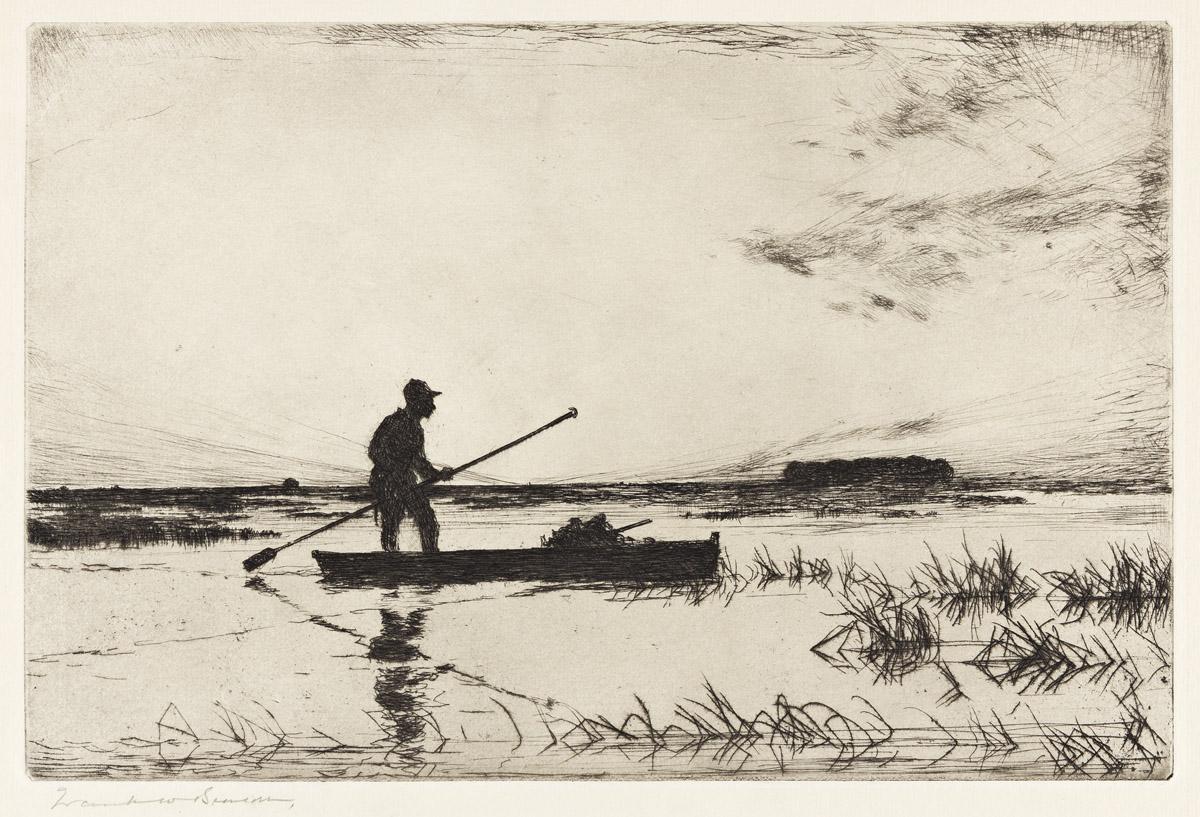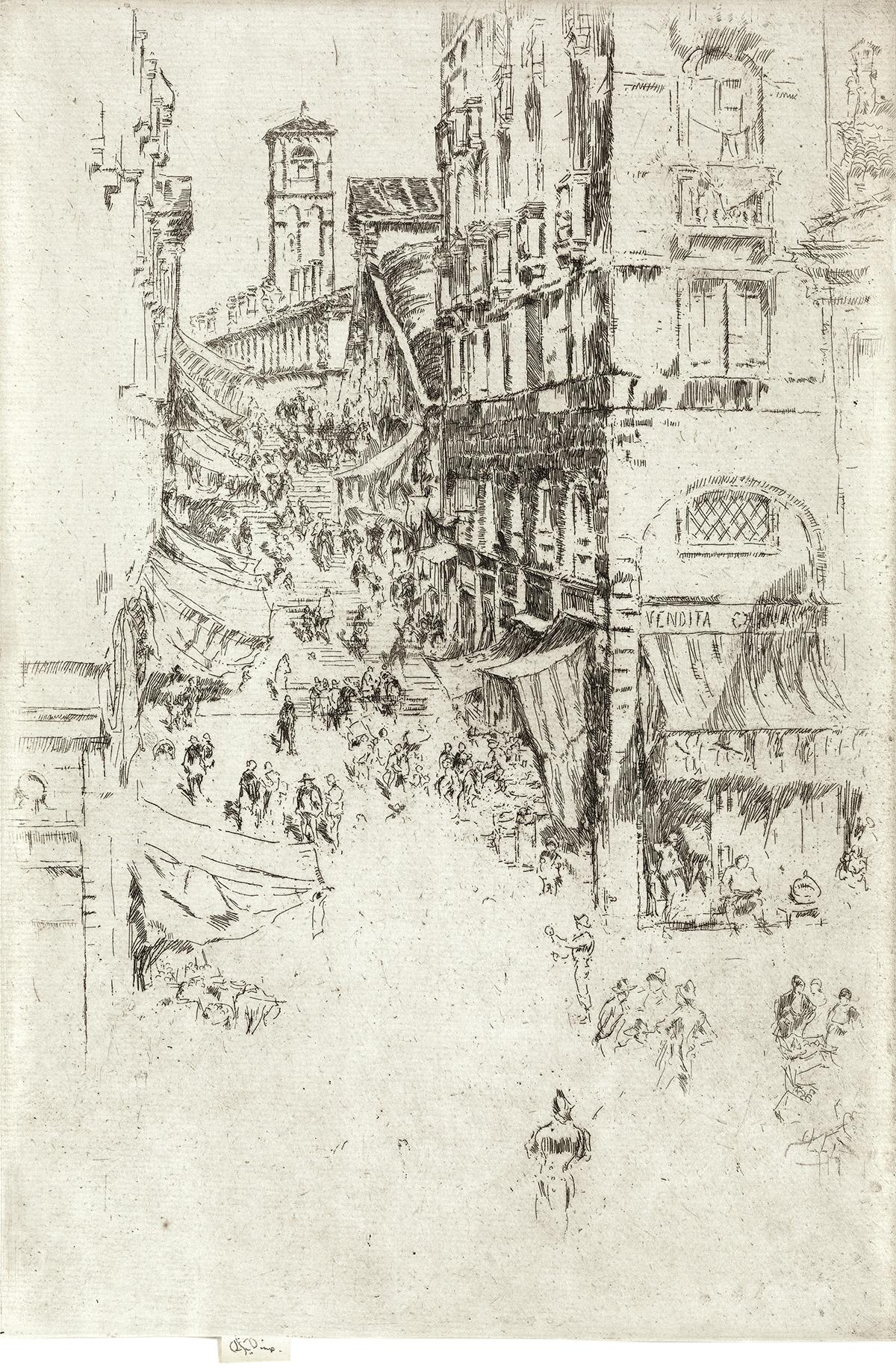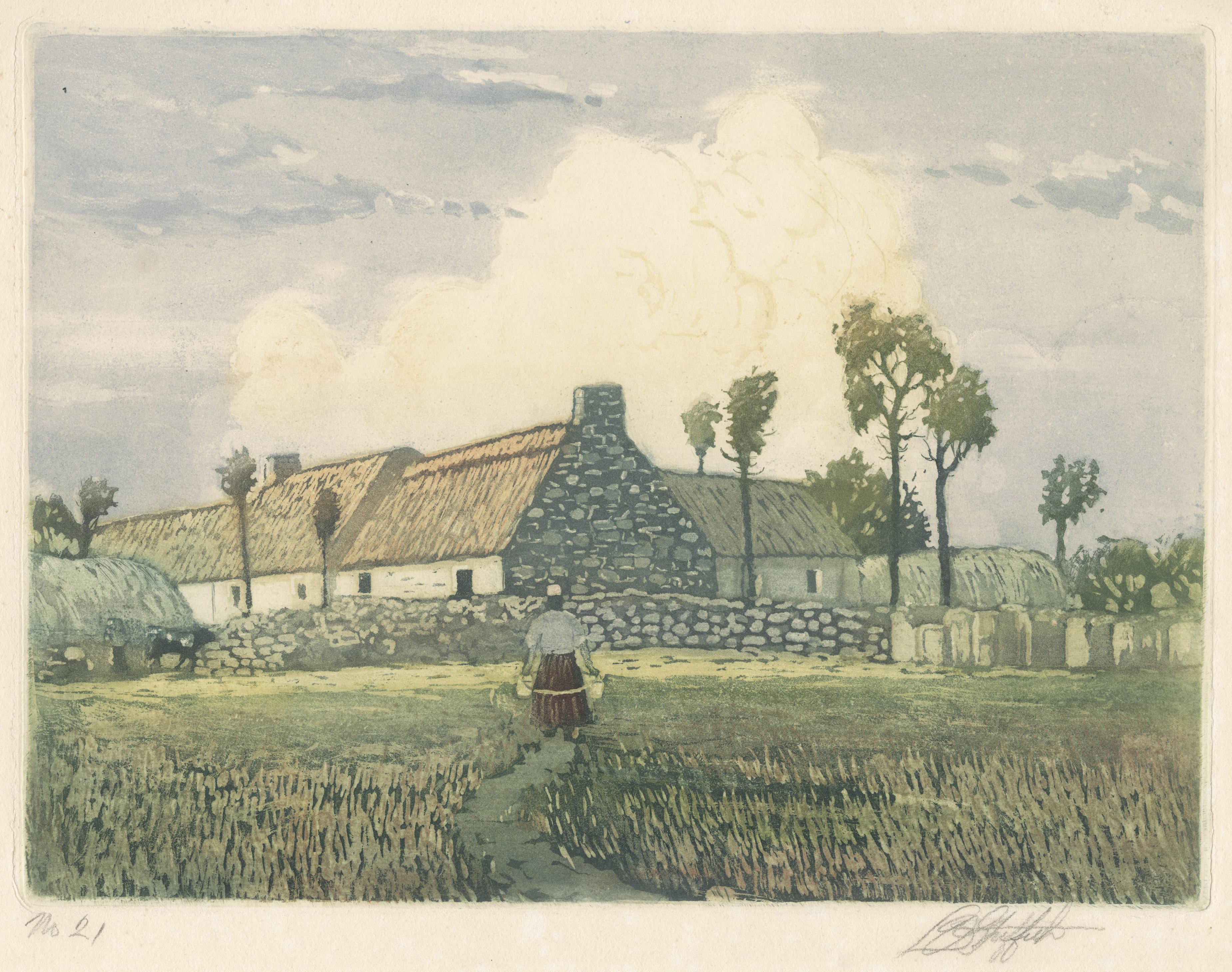Items Similar to Shipping
Want more images or videos?
Request additional images or videos from the seller
1 of 3
Kerr EbyShipping1932
1932
About the Item
Kerr Eby 'Shipping' also 'Shipping, Connecticut', etching and sandpaper ground, 1932, edition 100, Giardina 171. Signed in pencil and titled 'Shipping' in the bottom left sheet edge. A superb, atmospheric impression, with skillfully controlled plate tone, on heavy, cream wove paper; the full sheet with wide margins (2 to 2 3/4 inches), in excellent condition. Matted to museum standards, unframed.
Image size 8 3/8 x 17 1/4 inches (316 x 176 mm); sheet size 13 7/16 x 8 3/8 inches (341 x 213 mm).
The scene depicted was on the Connecticut coast.
Impressions of this work are in the permanent collections of the following institutions: American Academy and Institute of Arts and Letters, Hunterian Museum and Art Gallery (Glasgow, Scotland), Herbert F, Johnson Museum of Art, Metropolitan Museum of Art, National Museum of American Art, Smithsonian American Art Museum, University of Iowa Museum of Art, University of Wyoming Art Museum.
ABOUT THE ARTIST
Kerr Eby was born in 1890 in Tokyo, Japan, the son of Methodist missionaries from Canada. The family returned to Vancouver when Eby was only three, and he grew up studying art encouraged by his parents as his mother was from a family of prominent artists. By age twelve, he had lived in Vancouver, Kingston, Toronto and Bracebridge where he found work as a ‘printer’s devil’ on the local Bracebridge newspaper.
After graduating from high school in 1907, Eby moved to New York City to study art, first at the Pratt Institute, and later at the Art Students League. He enrolled in art classes at Pratt Institute while working for a lithographic firm earning $4.00 a week. His pay barely covered his room and drawing supplies. Within a year, starving and feeling defeated, he returned to Canada and was employed by a surveying party in Northern Ontario. Eby gradually regained his dream of becoming an artist, and in his spare time, he began to draw the surrounding wilderness landscapes. By fall he had returned to New York to attend night classes at the Art Students League while working for another lithographic firm. He spent several more summers surveying in Northern Ontario before he was able to make a living as an illustrator. During this period he formed several friendships with influential artists including John Henry Twachtman and Childe Hassam and joined a summer artists' colony founded by them at Cos Cob, Connecticut. He supported himself by working as a magazine illustrator and at the American Lithographic Company. Through diligent study and practice, Eby refined both his drawing and printmaking techniques.
In 1917, when the United States entered World War I, Eby joined the U.S. Army. Failing to obtain a commission as an artist, he was assigned first to ambulance duty and later as a sergeant in the 40th Engineers in France. He spent most of WWI on the front line as a camouflager of the field artillery ‘big guns”. On his time off duty, he would sketch everything he witnessed, from the explosive big guns and men in action to the dead soldiers in the field. He sent the drawings home each week, and upon his return from the war, they became the basis for his first successful group of etchings. He continued creating his war-related prints throughout the 1920s and '30s as his work became widely exhibited Frederick Keppel, the renowned print dealer and a relative of Eby, became the exclusive agent for many of his print editions.
With another global conflict beginning in the mid-1930s, Eby wanted to show the world the true face of war. In 1935, he published a book of this prints, entitled simply ‘War’. These powerful works depict the horror and disillusionment he experienced in combat and remain some of the most compelling anti-war images ever produced in this country. When the United States declared war in 1941, Eby tried to enlist but was turned down because of his age. He received his opportunity to serve, however, when Abbott Laboratories developed its combat artist program. Between October 1943 and January 1944, he traveled with Marines in the South Pacific and witnessed some of the fiercest fighting of the war, landing with the invasion force at Tarawa. While living three weeks in a foxhole in Bougainville Island, Papua New Guinea, he contracted a tropical disease, from which he never recovered. He completed his final drawings for Abbott but was unable to complete the etchings he intended to make. He died in Norwalk, Connecticut in 1946.
Eby was an Associate of the National Academy NA (1930); National Academy of Design (1934); Society of American Etchers; Chicago Society of Etchers; Philadelphia Society of Etchers; National Institute of Arts and Letters. Kerr Eby's work can be found in numerous museums and public collections.
- Creator:Kerr Eby (1890 - 1946, American)
- Creation Year:1932
- Dimensions:Height: 8.38 in (21.29 cm)Width: 17.25 in (43.82 cm)
- Medium:
- Movement & Style:
- Period:
- Condition:
- Gallery Location:Myrtle Beach, SC
- Reference Number:
About the Seller
5.0
Recognized Seller
These prestigious sellers are industry leaders and represent the highest echelon for item quality and design.
Platinum Seller
These expertly vetted sellers are 1stDibs' most experienced sellers and are rated highest by our customers.
Established in 1995
1stDibs seller since 2016
254 sales on 1stDibs
Typical response time: 2 hours
Associations
International Fine Print Dealers Association
- ShippingRetrieving quote...Ships From: Myrtle Beach, SC
- Return PolicyA return for this item may be initiated within 7 days of delivery.
More From This SellerView All
- 'Ship Rock, New Mexico' —By Albert GrollLocated in Myrtle Beach, SCAlbert Lorey Groll, 'Ship Rock, New Mexico', etching, c. 1910. Signed and titled in pencil. A fine, richly-inked impression on cream, wove paper, the full sheet with margins (1 to 1 3/8 inches); a slight paper defect in the center-left margin, away from the image, otherwise in excellent condition. Image size 7 7/8 x 10 inches (200 x 254 mm); sheet size 10 1/8 x 12 15/16 inches (257 x 329 mm). Scarce. Provenance: Ex. collection Kennedy Galleries, in their original gallery mat with label attached. ABOUT THE ARTIST Albert Lorey Groll (1866-1910) was born in New York in 1866, the son of a pharmacist immigrant from Darmstadt, Germany. During his early years, he traveled to Europe to study at the Royal Academy of Fine Arts in Munich under Nicholas Gysis and Ludwig von Löfftz. He further pursued his studies in London and at the Royal Academy of Fine Arts in Antwerp, Belgium. Groll returned to New York in 1895 and moved from figure to landscape painting while expanding his interests to printmaking. In 1904 Groll made the first of several trips to the American Southwest, traveling to Arizona with ethnographer Stewart Culin of the Brooklyn Museum. Later he went to New Mexico with his friend, the artist and illustrator William Robinson Leigh (see our 1stDibs listing no. LU53239015112 ). He focused on impressionistic scenes of Native American lands. The Laguna Pueblo people admired Groll's paintings, honoring him with the name "Chief Bald Head Eagle Eye." Groll kept a studio in the Gainsborough Studios in Manhattan and won several awards for his work in Arizona and New York, including the Salmagundi Club Shaw Prize in 1904 and a gold medal at the Pennsylvania Academy of Fine Arts in 1906. He was also awarded the George Inness gold medal from the National Academy of Design in 1912 for his painting of Lake Louise in the Canadian Rockies. In 1910 he was elected into the National Academy of Design and, in 1919, an associate member of the Taos Society...Category
1910s American Impressionist Landscape Prints
MaterialsEtching
- 'Black Hawk Country' — Early 20th-Century American ImpressionismLocated in Myrtle Beach, SCRalph M. Pearson, 'Black Hawk Country', etching, second state, edition not stated, 1912. Signed, and titled in pencil. Inscribed 'Rock River Series Second...Category
1910s American Impressionist Landscape Prints
MaterialsEtching
- St. Paul's Church (St. Paul's Chapel, New York City)By Bror Julius Olsson NordfeldtLocated in Myrtle Beach, SCB.J.O. Nordfeldt, 'St. Paul's Church' (St. Pauls' Chapel), etching, edition not stated, c. 1915. Signed in pencil. A superb, richly-inked impression, with skillfully controlled plate tone, printed on off-white, antique, laid paper; the full sheet with margins (5/8 to 2 1/4 inches), in very good condition. Scarce. Matted to museum standards, unframed. An impression of this work is in the permanent collection of the Smithsonian American Art Museum. ABOUT THE ARTIST A solo exhibition of Nordfeldt’s etchings and woodcuts was presented by the Smithsonian Institution in 1926. In 1920, Nordfeldt had a one-man show at the Chicago Arts Club. In 1926, he won the bronze medal at the sesquicentennial exposition in Philadelphia and the Logan Medal at the Art Institute of Chicago. In 1927, he won the first annual prize from the Brooklyn Society of Etchers, and the following year he won first prize from the Chicago Society of Etchers. In 1929, Nordfeldt had a one-man show at the Denver Art Museum. Nordfeldt's work is held in numerous museum collections including Amon Carter Museum of Western Art, Ft. Worth; Anschutz Collection, Denver; Art Institute of Chicago; Biblioteque d’Art et d’Archeologie, Paris; British Museum, London; Corcoran Gallery of Art, Washington, DC; Los Angeles County Museum; Metropolitan Museum of Art, New York City; Museum of Fine Arts, Santa Fe; National Museum of American Art, Smithsonian Institution, Washington, DC; National Gallery, Sydney, Australia; Phillips Collection, Washington, DC. ABOUT ST. PAUL'S CHAPEL St. Paul's Chapel, nicknamed "The Little Chapel That Stood", is an Episcopal chapel located at 209 Broadway, between Fulton Street and Vesey Street, in Lower Manhattan, New York City. Built in 1766, it is the oldest surviving church building in Manhattan, and one of the nation's finest examples of Late Georgian church architecture. It is a New York City Landmark and a National Historic Landmark. The Hearts of Oak, a militia unit organized early in the American Revolutionary War, and composed in part of King's College (later, Columbia University) students, would drill in the Chapel's yard before classes nearby. Alexander Hamilton was an officer of this unit. The chapel survived the Great New York City Fire of 1776 when a quarter of New York City (then confined to the lower tip of Manhattan), including Trinity Church, burned following the British capture of the city after the Battle of Long Island during the American Revolutionary War. George Washington, along with members of the United States Congress, worshipped at St. Paul's Chapel on his Inauguration Day, April 30, 1789. Washington also attended services at St. Paul's during the two years New York City was the country's capital. Above Washington's pew is an 18th-century oil painting of the Great Seal of the United States, adopted in 1782. The rear of St. Paul's Chapel faces Church Street, opposite the east side of the World Trade Center site. After the attacks on September 11, 2001, which led to the collapse of the twin towers of the World Trade Center, St. Paul's Chapel served as a place of rest and refuge for recovery workers at the WTC site. For eight months, hundreds of volunteers worked 12-hour shifts around the clock, serving meals, making beds, counseling and praying with firefighters, construction workers, police, and others. Massage therapists, chiropractors, podiatrists, and musicians also tended to their needs. The church survived without even a broken window. Church history declares it was spared by a miracle sycamore on the northwest corner of the property that was hit by debris. The tree's root has been preserved in a bronze memorial...Category
1910s American Impressionist Landscape Prints
MaterialsEtching
- Broad Street (Wall Street)By Bror Julius Olsson NordfeldtLocated in Myrtle Beach, SCB.J.O. Nordfeldt, 'Broad Street (Wall Street)', etching, edition not stated, c. 1915. Signed in pencil. A superb impression, with rich burr, selectively wiped plate tone, and inky plate edges, on cream wove paper; the full sheet with margins (3/4 to 1 1/4 inches), in excellent condition. Printed by the artist. Matted to museum standards, unframed. Impressions of this work are in the permanent collections of the Fine Arts Museums of San Francisco, Princeton University, Smithsonian American Art Museum. A view looking down Broad Street past the New York Stock Exchange Building on the right with the columned Federal Hall...Category
1910s American Impressionist Landscape Prints
MaterialsEtching
- 'North Boulder Creek, Colorado' —Southwest American ImpressionismBy George Elbert BurrLocated in Myrtle Beach, SCGeorge Elbert Burr, 'North Boulder Creek, Colorado', etching, c. 1915, Seeber 99. A superb, luminous impression, in dark sepia ink, with skilfully wiped plate tone, on cream laid pap...Category
1910s American Impressionist Landscape Prints
MaterialsEtching
- Grand Central, NightBy Walter TittleLocated in Myrtle Beach, SCWalter Tittle, 'Grand Central Night', drypoint, edition not stated, c. 1920s. Signed in pencil. Titled, and annotated '36.00' and with the inventory numb...Category
1920s American Impressionist Landscape Prints
MaterialsDrypoint
You May Also Like
- Earl Horter, (European Fountain)By Earl HorterLocated in New York, NYSigned in pencil. A European town square with fountain and tower.Category
Early 20th Century American Impressionist Landscape Prints
MaterialsEtching
- The PunterBy Frank BensonLocated in New York, NYA superb, richly-inked impression of this etching. Edition of 150. Signed in pencil, lower left.Category
1920s American Impressionist Abstract Prints
MaterialsEtching
- The RialtoBy James Abbott McNeill WhistlerLocated in New York, NYA superb, richly-inked impression of this etching and drypoint, printed in dark brownish black on antique cream laid paper. Second state (of 3). Edition of approximately 30. Signed w...Category
Late 19th Century American Impressionist Landscape Prints
MaterialsDrypoint, Etching
- Desolation, S.C. or Deserted Cabins, Beauford, S.C.By Louis Oscar GriffithLocated in Fairlawn, OHDesolation, S.C. or Deserted Cabins, Beauford, S.C. Etching & Aquatint, c. 1930 Signed by the artist in pencil lower right (see photo) Annotated "Trial Proof" in pencil lower left co...Category
1930s American Impressionist Landscape Prints
MaterialsAquatint
- Brittany Landscape with FigureBy Louis Oscar GriffithLocated in Fairlawn, OHBrittany Landscape with Figure Etching & color aquatint, c. 1920 Signed lower right (see photo) Numbered lower left: "No. 21" (see photo) An early ...Category
1920s American Impressionist Landscape Prints
MaterialsAquatint
- The Little Wheelwright'sBy James Abbott McNeill WhistlerLocated in Storrs, CTThe Little Wheelwright's. 1886. Etching. Kennedy 245; Glasgow 242. 2 1/2 x 3 3/4 (sheet 5 1/8 x 6 1/8). There was no lifetime edition. Glasgow lists only 13 other known impressions. A fine impression printed in black ink on white laid paper. Monogrammed with the butterfly in the plate. Housed in a 10 X 11 1/2 X 1-inch gold leaf period carved Celtic...Category
Mid-19th Century American Impressionist Figurative Prints
MaterialsEtching




